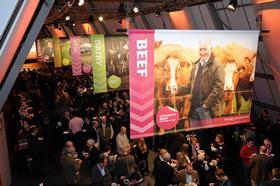
After four and a half months as chief executive of Sainsbury’s, Mike Coupe gave a business update in the first session of the sixth Sainsbury’s Farming Conference, held in Millbrook, Bedfordshire, at the start of December. He said his three ambitions since taking on the role have been to keep his head “below the parapet”, helped, he admitted, by “some noise from our friends in Cheshunt”; to meet colleagues across the Sainsbury’s business; and to set out his future strategy.
Store sizes and trends for the future
Coupe announced that Sainsbury’s will work on improving store layout, as well as exploring different sizes of stores. “Our market share of the convenience market is around six per cent. We currently have 670 convenience stores, and we think we can get to 1,500, continuing at our current rate of 100 new convenience stores every year,” he said.
“We are also looking at even smaller shops, such as squeezing it down to 1,000 sq ft, as well as larger convenience shops of between 7,000 sq ft and 8,000 sq ft.” He said technology will continue to play a key role in shaping future consumer trends, such as ‘subscribing’ to a regular commodity product so that a regular order turns up at the same time every week, and using mobile phones to scan and pay as you go around the shop to replace checkouts, as two potential trends for the future.
In today’s market, 68 per cent of grocery shopping is done in out-of-town superstores, nine per cent is done with the discounters, 24 per cent is in convenience stores and five per cent is online. Coupe predicted that in 2022, the percentage
of shopping done in superstores would drop to 58 per cent, but stressed that “the death of the superstore is largely
exaggerated”.
Commercial director Paul Mills-Hicks, who was appointed to the role in April last year, received appreciative murmurings from the audience after he threw down the gauntlet to supermarkets to focus less on promotions, and more on growing sales. He also said that value-chain analysis is “not necessarily about consolidation or playing people off against each other”. “What we don’t seem to have done is made the cake bigger for everyone. If we’re successful, you’re successful,” he said.
R&D case study
As well as announcing six annual R&D grants, two of which went to fresh produce collaborations, Sainsbury’s spotlighted successful projects from last year – including one looking at varietal selection through strawberry genetics.
The project, which looked at the relationship between root architecture and phosphorus to help create a more robust selection process for strawberry varieties, was awarded to grower Berries Direct Norfolk, asone of the largest berry suppliers to Sainsbury’s.
The producer’s general manager Brian Edwards said: “This is the first time we’ve tried to find a variety to suit the substrate we are using. In total the project will cost £1 million over four years, including £750,000 of Agri-Tech Strategy funding and £250,000 from commercial funding. Why it’s worth having a Sainsbury’s grant is they know more than anyone what the customer wants. And the other key benefit is it gives the project instant credibility, which makes it easier to attract public funding.”
Edwards said that developing varieties on a molecular level was unheard of a few years ago, and that a variety selection process for substrate growing systems is vital to drive the category forward. “The price of strawberries has not changed over the last few years, largely down to availability. We need a sustainable variety,” he said.



